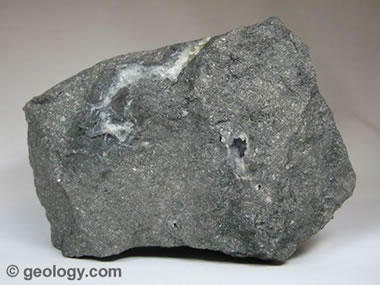Arsenopyrite
Mineral Properties and Uses
What is Arsenopyrite?
Arsenopyrite is an iron arsenic sulfide mineral with a chemical composition of FeAsS. It is the most abundant arsenic mineral and the primary ore of arsenic metal. In addition to being found in deposits that are large enough to be minable, arsenopyrite is widely distributed. However, it usually occurs in such small amounts and in such small particle sizes that it is easily overlooked. It is associated with other sulfide minerals in organic-rich sedimentary rocks, metamorphic rocks, and igneous rocks in many parts of the world.
Geologic Occurrence
Much of the arsenopyrite that has been mined formed as a high-temperature mineral in hydrothermal veins. It is often mined, together with other metallic minerals, from veins that might contain gold, silver, lead, tungsten, or tin. In these deposits arsenopyrite usually occurs in a granular massive form. It is often intergrown with other sulfide minerals such as chalcopyrite, galena, pyrrhotite, pyrite, and sphalerite; precious metals such as gold and silver; or other minerals such as scheelite, cassiterite, and quartz.Arsenopyrite has also been mined from sulfide deposits formed by contact metamorphism. It is occasionally found in pegmatites. Well-formed crystals of arsenopyrite are most often found in pegmatites and in carbonate rocks that have been altered by contact metamorphism.
Significant amounts of arsenopyrite have been produced from deposits in Germany, England, Bolivia, Japan, Greece, Spain, Sweden, Mexico, and Japan. In North America deposits are located in Ontario, Canada, and in South Dakota, New Jersey, and New Hampshire in the United States.
Arsenopyrite and Glaucodot
In some deposits, cobalt will substitute for some of the iron in the arsenopyrite crystal structure. This produces a solid solution series between arsenopyrite (FeAsS) and glaucodot ((Co,Fe)AsS).
Arsenopyrite: Massive granular arsenopyrite from Gold Hill, Utah. Specimen is approximately 10 centimeters across.
Weathering of Arsenopyrite
Arsenopyrite is unstable in most environments of Earth’s surface. It easily alters from its silver-white or steel-gray color to yield a bronze to brown tarnish. If a geologist strikes the mineral with a hammer to view a fresh surface or does a streak test, an odor of garlic might be detected. This is a characteristic of many arsenic minerals and a clue that arsenopyrite might be present.Arsenopyrite often oxidizes to form scorodite, a hydrated iron arsenate mineral with a chemical composition of FeAsO4.2H2O. Scorodite often weathers to limonite, an amorphous, hydrated iron oxide of variable composition. In areas where mining has exposed large amounts of sulfide ores, arsenopyrite can be a contributor to acid mine drainage problems.
Arsenopyrite as a Source of Gold
Arsenopyrite sometimes contains gold that is so small that it cannot be detected with a hand lens. This "invisible gold" can sometimes be recovered in economic quantities by crushing the ore, concentrating the heavy fraction, and treating the heavy fraction with cyanide to dissolve the gold.The "invisible gold" occurs in two forms: 1) tiny particles of elemental gold; and, 2) gold that is chemically bound within the arsenopyrite. Elemental gold exposed by crushing can be removed with the cyanide. The chemically bound gold is more difficult to remove without smelting.

The best way to learn about minerals is to study with a collection of small specimens that you can handle, examine, and observe their properties. Inexpensive mineral collections are available in the Geology.com Store.
Arsenopyrite By Other Names
The name “arsenopyrite” is a contraction of “arsenical pyrites,” an archaic name used for the mineral. “Mispickel” is another name for arsenopyrite.Uses of Arsenopyrite and Arsenic
Arsenopyrite is the primary ore of arsenic metal, which is used to produce alloys. It was historically used to harden lead in ammunition, but this use has declined in the past few decades.
Much arsenic is recovered by smelting in the form of arsenious oxide. This is used to produce a variety of insecticides, herbicides, pesticides, and chemical weapons. Arsenic compounds are also used in medicines, as pigments in paints, and to produce color in fireworks and glass.
From : https://geology.com/minerals/arsenopyrite.shtml
****************************************************************
Arsenopyrite
Arsenopyrite is an iron arsenic sulfide. It is a hard metallic, opaque, steel grey to silver white mineral with a relatively high specific gravity of 6.1. When dissolved in nitric acid, it releases elemental sulfur.
Mohs scale hardness: 5.5 - 6
Crystal system: Monoclinic
Crystal class: Prismatic (2/m); (same H-M symbol)
Optical properties: Anisotropism - strong red-violet
Crystal habit: Acicular, off-square prismatic, stubby; striated; also compact, granular, columnar
Streak: Black
Comments
Post a Comment